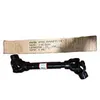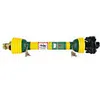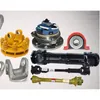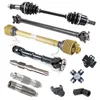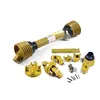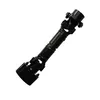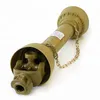A universal joint, often abbreviated as U-joint, is a mechanical device used to connect two rotating shafts at an angle, allowing the transmission of torque and rotation. It is commonly employed in automotive drive systems, industrial machinery, and various mechanical applications where flexibility in alignment is required. The design typically consists of a cross-shaped yoke with needle bearings, enabling smooth movement and efficient power transfer even when shafts are not perfectly aligned.
| Parameter | Value | Unit |
|---|---|---|
| Maximum Torque | 500-2000 | Nm |
| Operating Angle | Up to 45° | Degrees |
| Material | Forged Steel / Stainless Steel | - |
| Bearing Type | Needle Roller Bearings | - |
| Weight Range | 0.5-5.0 | kg |
| Temperature Range | -40°C to 120°C | - |
Universal joints are versatile components used across multiple industries. In automotive systems, they are critical for drive shafts, steering columns, and transmission linkages. Industrial applications include conveyor systems, agricultural equipment, and robotics. Their ability to accommodate misalignment makes them ideal for machinery where precision and reliability are paramount.
What is the typical lifespan of a universal joint?
The lifespan varies based on application and maintenance. Under normal conditions with proper lubrication, a universal joint can last 50,000 to 100,000 hours. Regular inspection for wear and tear is recommended to ensure optimal performance.
How do I know if my universal joint needs replacement?
Signs of a failing universal joint include unusual noises (e.g., clunking or squeaking), vibrations during operation, visible rust or damage, and excessive play in the joint. Immediate replacement is advised to prevent mechanical failure.
Can universal joints be used in high-speed applications?
Yes, but selection depends on design specifications. High-speed universal joints often feature precision balancing and advanced bearings to minimize centrifugal forces. Always refer to manufacturer guidelines for speed ratings.
Are there different types of universal joints?
Common types include single joint, double joint, and constant velocity (CV) joints. Single joints are simple and cost-effective, while CV joints provide smoother operation at higher angles, often used in front-wheel drive vehicles.
What maintenance is required for universal joints?
Regular lubrication is essential for longevity. Use manufacturer-recommended grease and intervals. Inspect for corrosion, cracks, or bearing wear periodically, especially in harsh environments.
Can I install a universal joint myself?
Installation requires mechanical expertise and tools like presses or pullers. Improper installation can lead to misalignment or failure. For safety and reliability, professional installation is recommended.
Choosing the right universal joint involves considering torque requirements, operating angles, environmental conditions, and speed. Always match specifications to your application needs and consult technical datasheets for compatibility.
